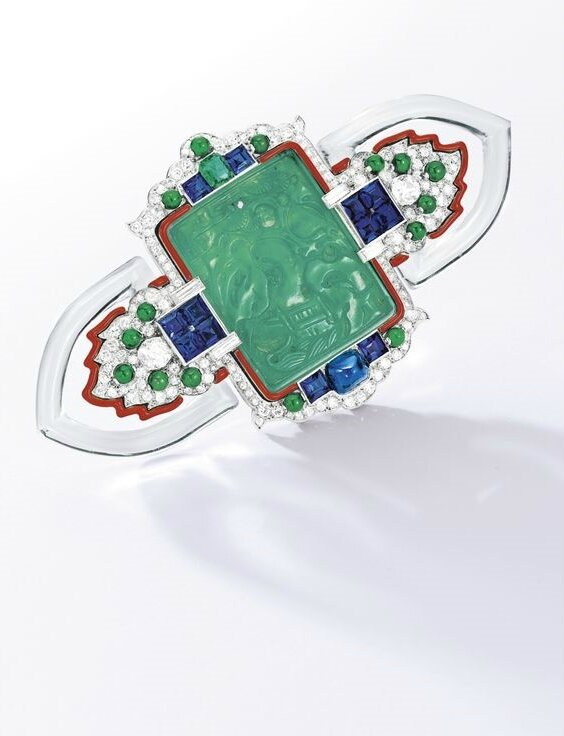Important Art Deco Jadeite, Enamel, Gem-Set and Diamond Brooch, Cartier, Circa 1927
Lot 1851. Important Art Deco Jadeite, Enamel, Gem-Set and Diamond Brooch, Cartier, Circa 1927. Estimate 7,000,000 — 8,000,000 HKD (820,380 - 937,577 EUR). Lot sold 7,280,000 HKD (836,879 EUR). Photo Sotheby's
Of modified quatrefoil shape, centring on a finely carved jadeite plaque of translucent apple green colour, carved with a garden scene on both sides measuring approximately 32.05 x 25.51 x 3.57mm, quartered by clusters of step-cut sapphires, a cabochon sapphire and a step-cut emerald, within a frame of palmette design set with baguette, old European- and single-cut diamonds and outlined by red enamel, completed by terminals set with two shield-shaped carved rock crystal, embellished by jadeite beads, the sapphires and diamonds together weighing approximately 6.90 and 3.05 carats respectively, mounted in platinum, signed Cartier and numbered 2716472.
Accompanied by a Cartier Certificate of Authenticity and a signed box.
EXOTICISM AT ITS BEST
Many would be surprised to learn that during the reign of Louis XIV of France, it was considered highly fashionable to attend masquerades where Chinese instruments were played and guests were dressed in delicate silk costumes. This China-frenzy in the 17th century, which also impacted artistic styles in decoration, architecture and fashion, was just an overture to this ballad of East and West. Centuries have passed before the highest note was hit in the 1920s, the period better known as Art Deco.
In the beginning of 20th century, far-off destinations such as Egypt, India, Persia and the Far East were becoming increasingly accessible, so was their wealth of arts, exotic materials and captivating palette. Among the jewellers who were inspired by these new elements was the Cartier family, who had already earned its reputation as the ‘jeweler to the kings’ by that time. The Cartier brothers were extremely well-read in history and were avid collectors of art. Aside from frequenting antique shops in France, they often travelled around the world with a focus on ancient civilizations. This acumen in foreign cultures and aesthetics was transformed into extensive archives and libraries, which they shared with their colleagues early on, and from which designers for generations took inspiration and strived to put out innovative creations.
Many of Cartier’s Art Deco designs were delicate combinations of oriental motifs and fragments of artifact, juxtaposed with precious stones within geometrical lines and expressed by a flamboyant mix of colours. A good example was the collection of Egyptian revival jewelleries that were sold in Sotheby’s New York in 2013. One of the brooches used a faience as its centrepiece, with a lapis lazuli background bordered by monochromatic diamonds and onyx.
A magnificent and rare Egyptian-revival faience and jeweled brooch by Cartier London sold for US$1,025,000 in Sotheby’s New York in December 2013.
This attempt at mixing materials and bold colours was even more significant in the maison’s Tutti Frutti pieces, which marked Cartier’s first foray into carved gemstones. These bright and colourful creations always encompass carved rubies, emeralds and sapphires, which are very likely to have been brought back by Jacques Cartier from his voyage in India. Though the colours red, blue and green might seem to clash violently at first glance, they were ingeniously organized such that the result was always an opulent explosion of colours . This has since then became a Cartier signature and was patented in 1989. The penannular brooch (Lot 1850) offered here is exemplary of this style, also employing high polish black onyx which was distinctive of Cartier’s designs during that period. This form of jewel was worn on belts, sashes, one’s shoulder, or pinned onto cloche hats for both decorative and functional purposes.
An 'Tutti Frutti' Bracelet by Cartier sold for US$1,445,000 in Sotheby’s New York in April 2013.
An Art Deco jadeite, diamond and multi-gem ‘Tutti Frutti’ Bracelet by Cartier. Private Collection
Aside from Egypt and India, the curiosity and fascination extended itself to the Far East, where sources of inspiration were drawn from Chinese and Japanese culture and various forms of art. While retaining the original flavour of Chinese artworks such as jadeite carvings and belt buckles, Cartier incorporated such elements into creations adjusted to meet European aesthetic tastes. This one-of-a-kind brooch (Lot 1851) perfectly illustrates the maison’s elevated skills in blending colours, textures and periods. By outlining the green jadeite by red enamel which evokes the 19th century cinnabar lacquer from Imperial China, and completing the ‘tutti frutti’ colour with careful arrangement of sapphires, emerald and jadeite beads, the maison stayed true to its audacity and subtle elegance. In addition, judging from the very fine pictorial carving on both sides of the jadeite plaque, it is likely to date from Qing dynasty. The Indo-Persian palmette motifs on the brooch are also stylised interpretation of an oriental decorative element seen in Persian rugs and classical mouldings. These naturalistic lines were then neatly contoured by the shield-shaped rock crystal frame.
These two Art Deco brooches are not only representative of Cartier’s imaginative faculty, it also attests to the fruitful encounter of East and West almost a century ago, culminating in originality, integration and lasting elegance.
Sotheby's. Magnificent Jewels & Jadeite, Hong Kong, 07 oct. 2015, 02:00 PM

/https%3A%2F%2Fprofilepics.canalblog.com%2Fprofilepics%2F1%2F0%2F100183.jpg)
/https%3A%2F%2Fstorage.canalblog.com%2F03%2F02%2F119589%2F96711876_o.jpg)
/https%3A%2F%2Fstorage.canalblog.com%2F11%2F31%2F119589%2F94773502_o.jpg)
/https%3A%2F%2Fstorage.canalblog.com%2F20%2F83%2F119589%2F94772815_o.jpg)
/https%3A%2F%2Fstorage.canalblog.com%2F26%2F72%2F119589%2F75604929_o.jpg)
/https%3A%2F%2Fstorage.canalblog.com%2F59%2F60%2F119589%2F26458628_o.jpg)







/image%2F1371349%2F20240315%2Fob_456a00_f12fdad5-0750-48f5-ae8f-7bd6836745f7.jpg)
/http%3A%2F%2Fstorage.canalblog.com%2F86%2F67%2F119589%2F129815803_o.png)
/http%3A%2F%2Fstorage.canalblog.com%2F40%2F54%2F119589%2F128112000_o.jpg)
/http%3A%2F%2Fstorage.canalblog.com%2F97%2F36%2F119589%2F128062654_o.png)